Evaluating the Adaptability and Sustainability of Different Straw Incorporation Strategies in Northeastern China: Impacts on Rice Yield Formation, Nitrogen Use Efficiency, and Temporal Soil Nutrient Dynamics
Abstract
:1. Introduction
2. Materials and Methods
2.1. Description of the Experimental Site
2.2. Experimental Design and Treatments
2.3. Sampling and Measurement
2.4. Statistical Analysis and Calculations
3. Results and Analysis
3.1. Rice Growth Dynamics
3.2. Rice Grain Yield and Nitrogen Recovery Efficiency
3.3. Soil Factor Dynamics During Rice Cultivation
3.4. Soil Physical Structure, Total Nutrients, and Enzyme Activity
3.5. Soil Environmental Factor Dynamics, Rice Growth Dynamics, and Yield Formation
4. Discussion
4.1. Effects of Different Straw Incorporation Regimes on Rice Growth Dynamics
4.2. Effects of Different Straw Incorporation Regimes on Soil Fertilization and Nutrient Availability
4.3. Factor Analysis of the Effects of Different Straw Incorporation Regimes on Rice Yield Formation
4.4. Insights and Prospects
5. Conclusions
Supplementary Materials
Author Contributions
Funding
Data Availability Statement
Conflicts of Interest
References
- National Bureau of Statistics. 2021. Available online: https://data.stats.gov.cn (accessed on 12 December 2021).
- Bu, R.; Li, M.; Cheng, W.; Han, S.; Wang, H.; Tang, S.; Lu, C.; Wu, J. Subsoil Tillage and Organic Fertilization Benefit Rice Root Growth and Yield by Ameliorating Soil Compaction and Fertility. J. Soil Sci. Plant Nutr. 2023, 23, 6114–6124. [Google Scholar] [CrossRef]
- Li, Z.; Shen, Y.; Zhang, W.; Zhang, H.; Liu, L.; Wang, Z.; Gu, J.; Yang, J. Effects of Long-Term Straw Returning on Rice Yield and Soil Properties and Bacterial Community in a Rice-Wheat Rotation System. Field Crops Res. 2023, 291, 108800. [Google Scholar] [CrossRef]
- Tang, H.; Wang, D.; Zhao, J.; Xu, C.; Wang, J. Mode and Experiments of a Straw Ditch-Burying Returning and Maturing in Cold Region of Northeast China. Eur. J. Agron. 2023, 151, 127006. [Google Scholar] [CrossRef]
- Zhang, M.; Dang, P.; Haegeman, B.; Han, X.; Wang, X.; Pu, X.; Qin, X.; Siddique, K.H.M. The Effects of Straw Return on Soil Bacterial Diversity and Functional Profiles: A Meta-Analysis. Soil Biol. Biochem. 2024, 195, 109484. [Google Scholar] [CrossRef]
- Yang, J.; Luo, Y.; Chen, J.; Jin, M.; Wang, Z.; Li, Y. Effects of Main Food Yield Under Straw Return in China: A Meta-Analysis. Sci. Agric. Sin. 2020, 53, 4415–4429. [Google Scholar] [CrossRef]
- Wang, L.; Wang, E.; Chen, G.; Qian, X.; Liu, Q.; Gao, Y.; Zhang, H.; Liu, K.; Li, Z. Optimizing Straw Return to Enhance Grain Production and Approach Carbon Neutrality in the Intensive Cropping Systems. Soil Tillage Res. 2025, 248, 106447. [Google Scholar] [CrossRef]
- Tian, P.; Sui, P.; Lian, H.; Wang, Z.; Meng, G.; Sun, Y.; Wang, Y.; Su, Y.; Ma, Z.; Qi, H.; et al. Maize Straw Returning Approaches Affected Straw Decomposition and Soil Carbon and Nitrogen Storage in Northeast China. Agronomy 2019, 9, 818. [Google Scholar] [CrossRef]
- Yan, C.; Yan, S.-S.; Jia, T.-Y.; Dong, S.-K.; Ma, C.-M.; Gong, Z.-P. Decomposition Characteristics of Rice Straw Returned to the Soil in Northeast China. Nutr. Cycl. Agroecosyst. 2019, 114, 211–224. [Google Scholar] [CrossRef]
- Che, W.; Piao, J.; Gao, Q.; Li, X.; Li, X.; Jin, F. Response of Soil Physicochemical Properties, Soil Nutrients, Enzyme Activity and Rice Yield to Rice Straw Returning in Highly Saline-Alkali Paddy Soils. J. Soil Sci. Plant Nutr. 2023, 23, 4396–4411. [Google Scholar] [CrossRef]
- Nakajima, M.; Cheng, W.; Hanayama, S.; Okada, M. Shallow Autumn Tillage Does Not Reduce CH4 Emission from an Andisol Paddy Field in Morioka, a Cold Region in Japan. J. Agric. Meteorol. 2017, 73, 92–99. [Google Scholar] [CrossRef]
- Zhang, P.; Chen, P.; Nie, T.; Zhang, Z.; Li, T.; Dai, C.; Jiang, L.; Wu, Y.; Sun, Z.; Yin, S. Long-Term Straw Incorporation under Controlled Irrigation Improves Soil Quality of Paddy Field and Rice Yield in Northeast China. Plants 2024, 13, 1357. [Google Scholar] [CrossRef]
- Cheng, S.; Xing, Z.; Tian, C.; Liu, M.; Feng, Y.; Zhang, H. Optimized Tillage Methods Increase Mechanically Transplanted Rice Yield and Reduce the Greenhouse Gas Emissions. J. Integr. Agric. 2024, 23, 1150–1163. [Google Scholar] [CrossRef]
- Wu, P.; Li, L.; Wang, X. Shallow Plough Tillage with Straw Return Increases Rice Yield by Improving Nutrient Availability and Physical Properties of Compacted Subsurface Soils. Nutr. Cycl. Agroecosyst. 2023, 127, 69–83. [Google Scholar] [CrossRef]
- Wang, X.; Samo, N.; Zhao, C.; Wang, H.; Yang, G.; Hu, Y.; Peng, Y.; Rasul, F. Negative and Positive Impacts of Rape Straw Returning on the Roots Growth of Hybrid Rice in the Sichuan Basin Area. Agronomy 2019, 9, 690. [Google Scholar] [CrossRef]
- Jakab, G.; Madarász, B.; Szabó, J.; Tóth, A.; Zacháry, D.; Szalai, Z.; Kertész, Á.; Dyson, J. Infiltration and Soil Loss Changes during the Growing Season under Ploughing and Conservation Tillage. Sustainability 2017, 9, 1726. [Google Scholar] [CrossRef]
- Zhang, B.; Pang, C.; Qin, J.; Liu, K.; Xu, H.; Li, H. Rice Straw Incorporation in Winter with Fertilizer-N Application Improves Soil Fertility and Reduces Global Warming Potential from a Double Rice Paddy Field. Biol. Fertil. Soils 2013, 49, 1039–1052. [Google Scholar] [CrossRef]
- Zhang, Y.; Hou, W.; Chi, M.; Sun, Y.; An, J.; Yu, N.; Zou, H. Simulating the Effects of Soil Temperature and Soil Moisture on CO2 and CH4 Emissions in Rice Straw-Enriched Paddy Soil. CATENA 2020, 194, 104677. [Google Scholar] [CrossRef]
- Wang, K.; Hu, W.; Xu, Z.; Xue, Y.; Zhang, Z.; Liao, S.; Zhang, Y.; Li, X.; Ren, T.; Cong, R.; et al. Seasonal Temporal Characteristics of In Situ Straw Decomposition in Different Types and Returning Methods. J. Soil Sci. Plant Nutr. 2022, 22, 4228–4240. [Google Scholar] [CrossRef]
- Takakai, F.; Goto, M.; Watanabe, H.; Hatakeyama, K.; Yasuda, K.; Sato, T.; Kaneta, Y. Effects of the Autumn Incorporation of Rice Straw and Application of Lime Nitrogen on Methane and Nitrous Oxide Emissions and Rice Growth of a High-Yielding Paddy Field in a Cool-Temperate Region in Japan. Agriculture 2021, 11, 1298. [Google Scholar] [CrossRef]
- Samoy-Pascual, K.B.; Sibayan, E.S.; Grospe, F.T.; Remocal, A.; T-Padre, A.; Tokida, T.; Minamikawa, K. Is Alternate Wetting and Drying Irrigation Technique Enough to Reduce Methane Emission from a Tropical Rice Paddy? Soil Sci. Plant Nutr. 2019, 65, 203–207. [Google Scholar] [CrossRef]
- Sun, Y.; Zhang, W.; Xiu, L.; Gu, W.; Wu, D.; Tang, L.; Chen, W. Long-Term Fertilization Regimes Modulate Dissolved Organic Matter Molecular Chemodiversity and Greenhouse Gas Emissions in Paddy Soil. Biochar 2025, 7, 43. [Google Scholar] [CrossRef]
- Dick, R.P.; Dick, L.K.; Deng, S.; Li, X.; Kandeler, E.; Poll, C.; Freeman, C.; Jones, T.G.; Weintraub, M.N.; Esseili, K.A.; et al. Cross-Laboratory Comparison of Fluorimetric Microplate and Colorimetric Bench-Scale Soil Enzyme Assays. Soil Biol. Biochem. 2018, 121, 240–248. [Google Scholar] [CrossRef]
- Wang, L.; Hamel, C.; Lu, P.; Wang, J.; Sun, D.; Wang, Y.; Lee, S.-J.; Gan, G.Y. Using Enzyme Activities as an Indicator of Soil Fertility in Grassland—An Academic Dilemma. Front. Plant Sci. 2023, 14, 1175946. [Google Scholar] [CrossRef] [PubMed]
- Knight, M.J.; Rowe, P.N. On Measuring the Density of Fine Particles by Pycnometry. Chem. Eng. Sci. 1980, 35, 997–1003. [Google Scholar] [CrossRef]
- Bao, S. Soil Agrochemical Analysis; China Agriculture Press: Beijing, China, 2000. [Google Scholar]
- Nayak, A.K.; Gangwar, B.; Shukla, A.K.; Mazumdar, S.P.; Kumar, A.; Raja, R.; Kumar, A.; Kumar, V.; Rai, P.K.; Mohan, U. Long-Term Effect of Different Integrated Nutrient Management on Soil Organic Carbon and Its Fractions and Sustainability of Rice–Wheat System in Indo Gangetic Plains of India. Field Crop. Res. 2012, 127, 129–139. [Google Scholar] [CrossRef]
- Kong, F.; Jiu, A.; Kan, Z.; Zhou, J.; Yang, H.; Li, F.-M. Deep Tillage Combined with Straw Biochar Return Increases Rice Yield by Improving Nitrogen Availability and Root Distribution in the Subsoil. Field Crop. Res. 2024, 315, 109481. [Google Scholar] [CrossRef]
- Ninkuu, V.; Liu, Z.; Qin, A.; Xie, Y.; Song, X.; Sun, X. Impact of Straw Returning on Soil Ecology and Crop Yield: A Review. Heliyon 2025, 11, e41651. [Google Scholar] [CrossRef]
- Tang, J.; Zhang, R.; Li, H.; Tan, J.; Song, W.; Wen, X.; Lu, B.; Hu, Z. The Combination of Different Nitrogen Fertilizer Types Could Promote Rice Growth by Alleviating the Inhibition of Straw Decomposition. Food Energy Secur. 2021, 10, e298. [Google Scholar] [CrossRef]
- Gao, J.; Ran, C.; Hou, H.; Guo, L.; Zhang, Q.; Geng, Y.; Shao, X. Synergistic Improvement of Straw Decomposition and Rice Yield in Saline Sodic Paddy Soils by Rational Nitrogen Application. Plant Soil 2024. [Google Scholar] [CrossRef]
- Yan, D.; Zhu, Y.; Wang, S.; Cao, W. A Quantitative Knowledge-Based Model for Designing Suitable Growth Dynamics in Rice. Plant Prod. Sci. 2006, 9, 93–105. [Google Scholar] [CrossRef]
- Liu, Q.; Dai, H.; Wang, L.; Qian, X.; Gao, Y.; Zhang, H.; Liu, K.; Li, Z.; Zamanian, K. Microbial Community and Functions Depending on Tillage and Straw Returning Management: Consequences for Soil Health and Ecosystem Services. Land Degrad. Dev. 2024, 35, 5357–5366. [Google Scholar] [CrossRef]
- Wang, X.; Liang, C.; Mao, J.; Jiang, Y.; Bian, Q.; Liang, Y.; Chen, Y.; Sun, B. Microbial Keystone Taxa Drive Succession of Plant Residue Chemistry. ISME J. 2023, 17, 748–757. [Google Scholar] [CrossRef]
- Liu, X.; Liu, H.; Zhang, Y.; Chen, G.; Li, Z.; Zhang, M. Straw Return Drives Soil Microbial Community Assemblage to Change Metabolic Processes for Soil Quality Amendment in a Rice-Wheat Rotation System. Soil Biol. Biochem. 2023, 185, 109131. [Google Scholar] [CrossRef]
- Li, R.-C.; Tian, Y.-G.; Wang, F.; Sun, Y.-F.; Lin, B.-J.; Dang, Y.P.; Zhao, X.; Zhang, H.-L.; Xu, Z.-Y. Optimizing the Rate of Straw Returning to Balance Trade-Offs between Carbon Emission Budget and Rice Yield in China. Sustain. Prod. Consum. 2024, 47, 166–177. [Google Scholar] [CrossRef]
- Liu, Z.; Xu, N.; Cao, T.; An, Z.; Yang, X.; He, T.; Yang, T.; Meng, J. Maize Straw Is More Effective than Maize Straw Biochar at Improving Soil N Availability and Gross N Transformation Rate. Eur. J. Soil Sci. 2023, 74, e13403. [Google Scholar] [CrossRef]
- Lehmann, J.; Bossio, D.A.; Kögel-Knabner, I.; Rillig, M.C. The Concept and Future Prospects of Soil Health. Nat. Rev. Earth Environ. 2020, 1, 544–553. [Google Scholar] [CrossRef] [PubMed]
- Wang, J.; Sun, C.; Zhang, Y.; Xiao, J.; Ma, Y.; Jiang, J.; Jiang, Z.; Zhang, L. Straw Return Rearranges Soil Pore Structure Improving Soil Moisture Memory in a Maize Field Experiment under Rainfed Conditions. Agric. Water Manag. 2024, 306, 109164. [Google Scholar] [CrossRef]
- Chen, S.; Xia, X.; Ding, Y.; Feng, X.; Lin, Q.; Li, T.; Bian, R.; Li, L.; Cheng, K.; Zheng, J.; et al. Changes in Aggregate-Associated Carbon Pools and Chemical Composition of Topsoil Organic Matter Following Crop Residue Amendment in Forms of Straw, Manure and Biochar in a Paddy Soil. Geoderma 2024, 448, 116967. [Google Scholar] [CrossRef]
- Zhang, B.-Y.; Dou, S.; Guan, S. Enhancement of Soil Humic Acid Hydrophobicity by 5 Consecutive Years of Full-Amount Straw Shallow-Mixed Field Return. Eur. J. Agron. 2024, 161, 127378. [Google Scholar] [CrossRef]
- Folberth, C.; Khabarov, N.; Balkovič, J.; Skalský, R.; Visconti, P.; Ciais, P.; Janssens, I.A.; Peñuelas, J.; Obersteiner, M. The Global Cropland-Sparing Potential of High-Yield Farming. Nat. Sustain. 2020, 3, 281–289. [Google Scholar] [CrossRef]
- Zhao, Y.; Wang, S.; Zhang, M.; Zeng, L.; Zhang, L.; Huang, S.; Zhang, R.; Zhou, W.; Ai, C. Nitrogen Application and Rhizosphere Effect Exert Opposite Effects on Key Straw-Decomposing Microorganisms in Straw-Amended Soil. Microorganisms 2024, 12, 574. [Google Scholar] [CrossRef] [PubMed]
- Chen, S.; Zhao, C.; Yang, W.; Wang, W.; Zhu, Q.; He, M.; Elrys, A.S.; Meng, L.; Meng, H.; Cai, Z.; et al. Enhancing Rice Nitrogen Use Efficiency via Plant-Microbe-Soil Interactions: Insights from 15N Tracing. Appl. Soil Ecol. 2025, 207, 105931. [Google Scholar] [CrossRef]
- Yang, H.; Zhou, J.; Feng, J.; Zhai, S.; Chen, W.; Liu, J.; Bian, X. Ditch-Buried Straw Return: A Novel Tillage Practice Combined with Tillage Rotation and Deep Ploughing in Rice-Wheat Rotation Systems. In Advances in Agronomy; Elsevier: Amsterdam, The Netherlands, 2019; Volume 154, pp. 257–290. ISBN 978-0-12-817406-7. [Google Scholar]
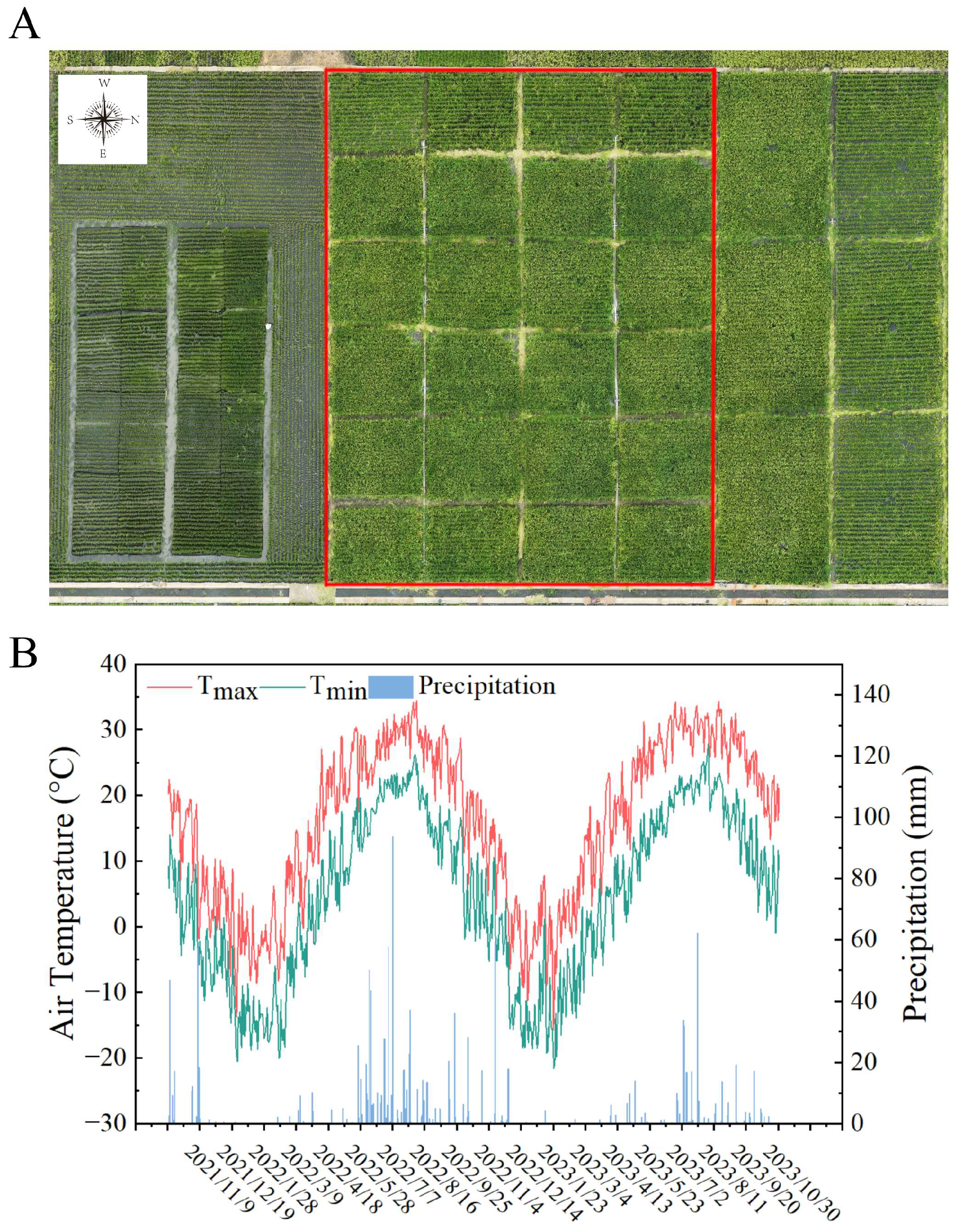

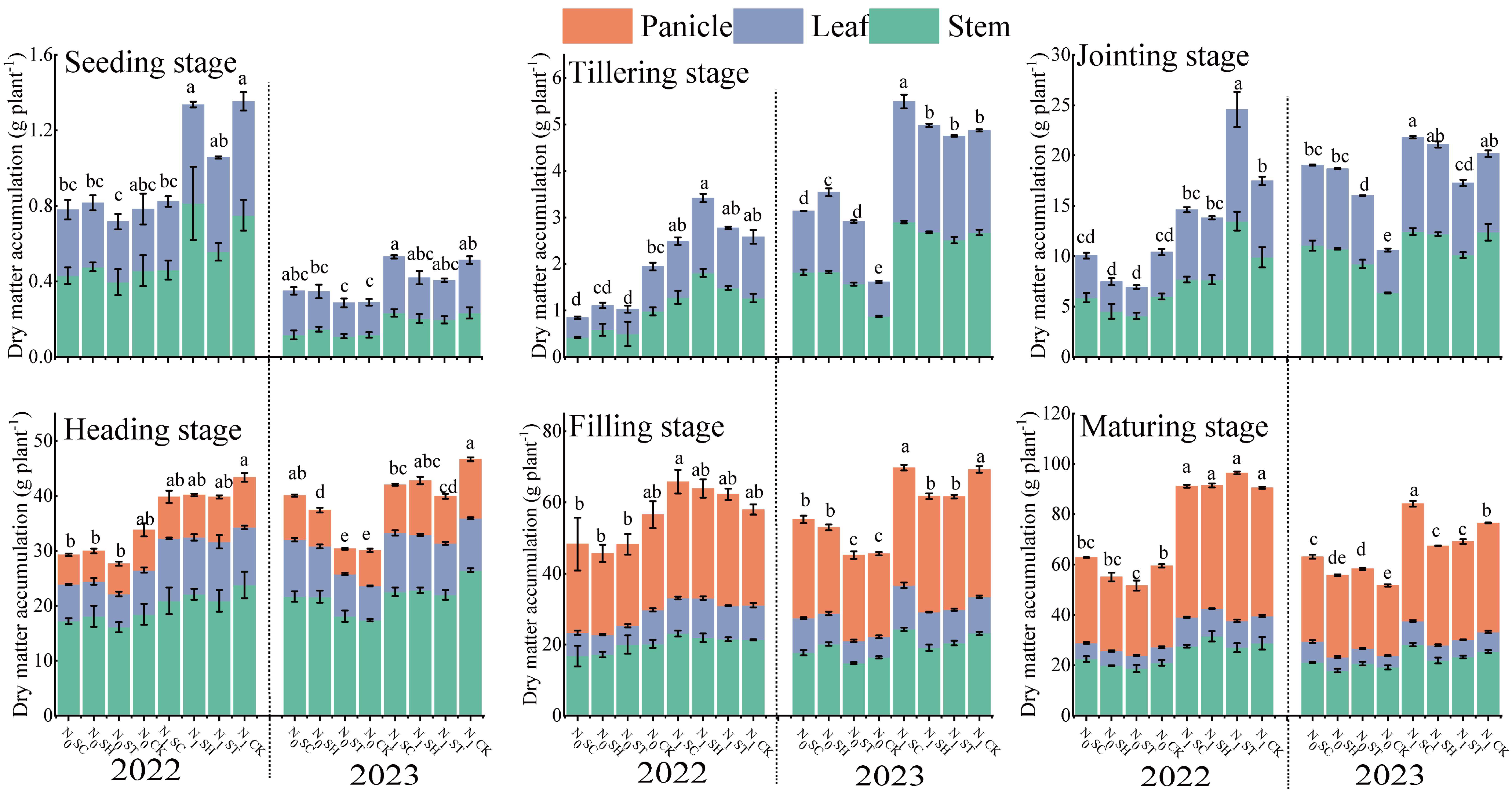

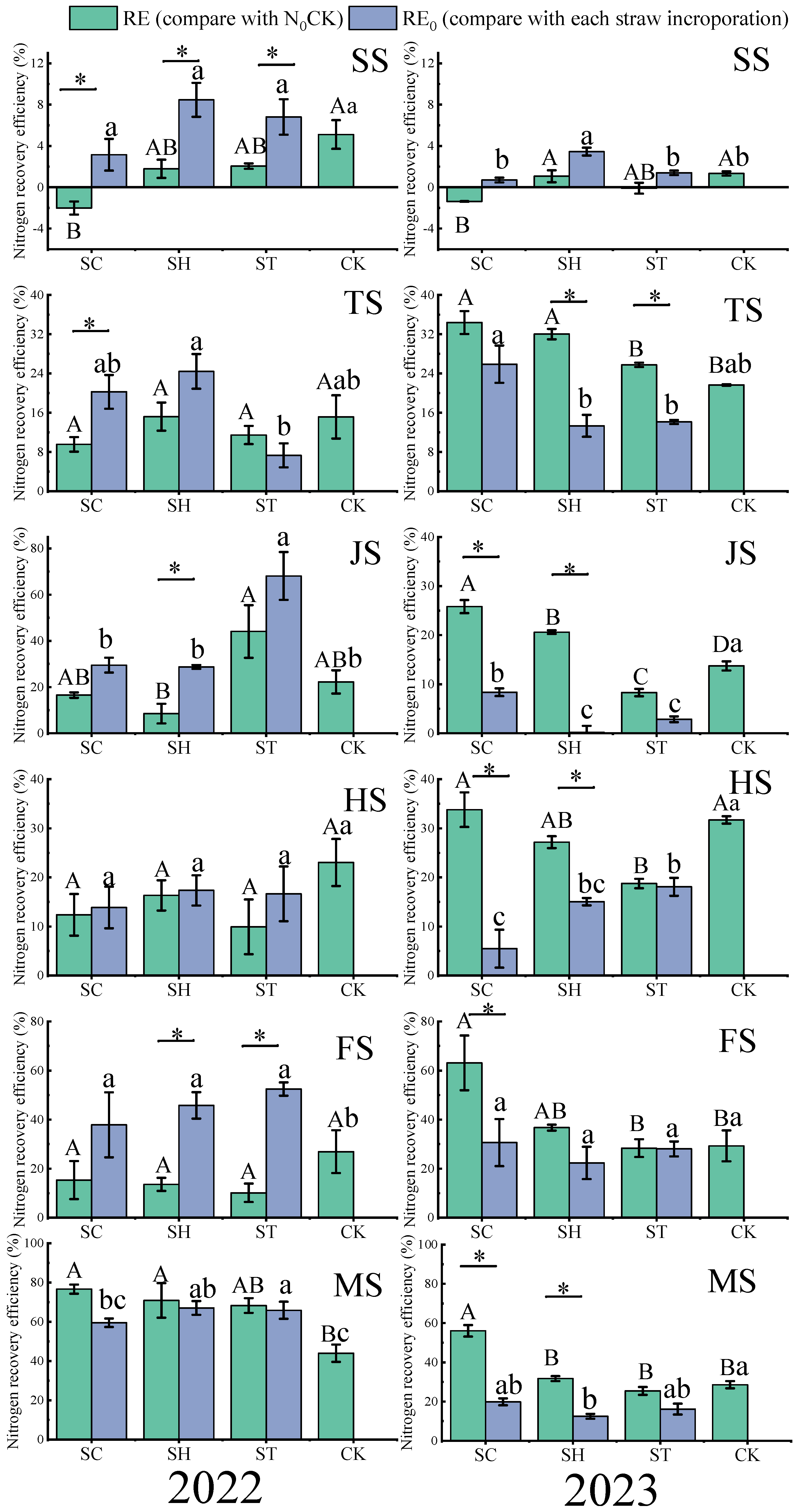


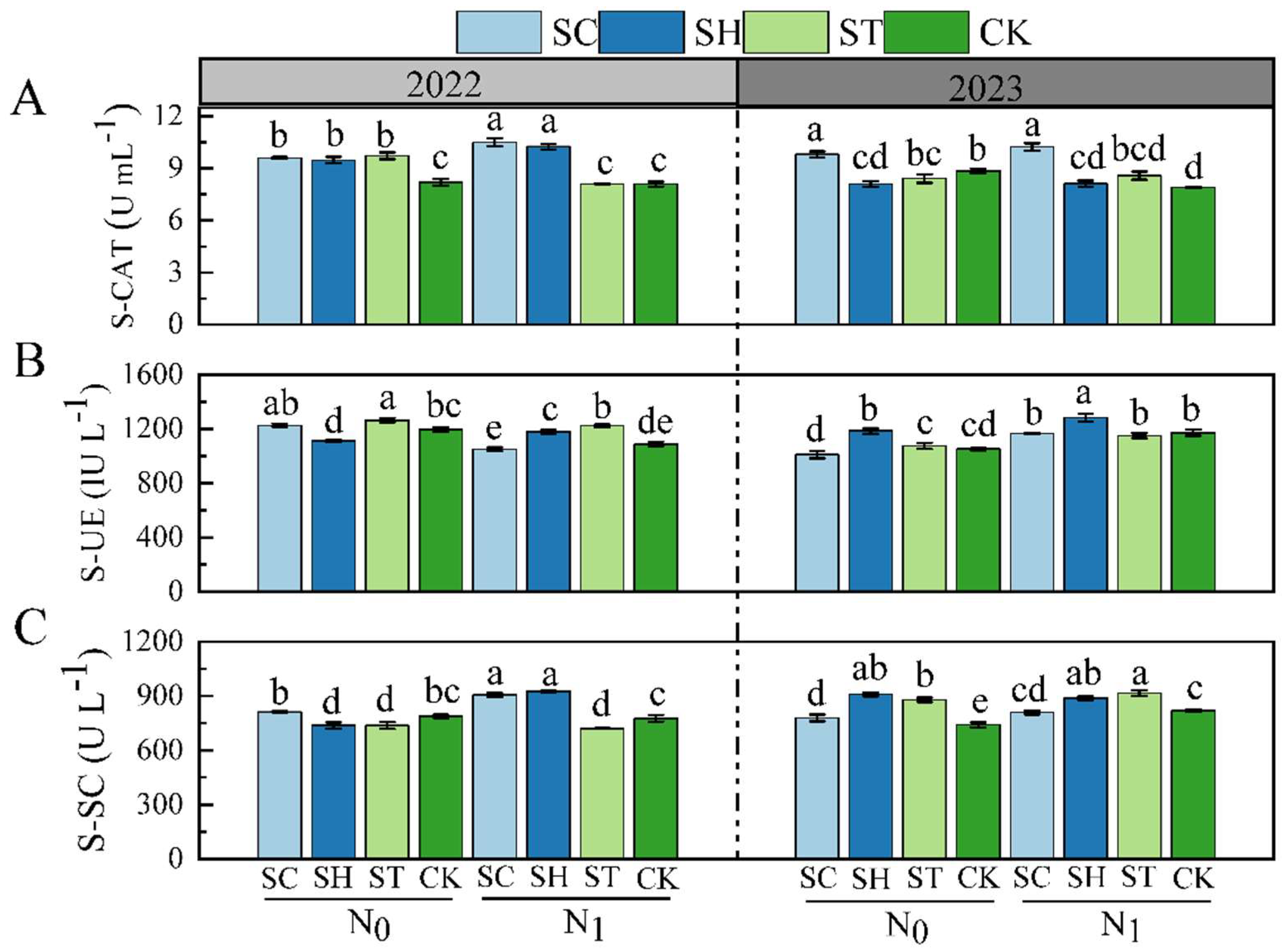

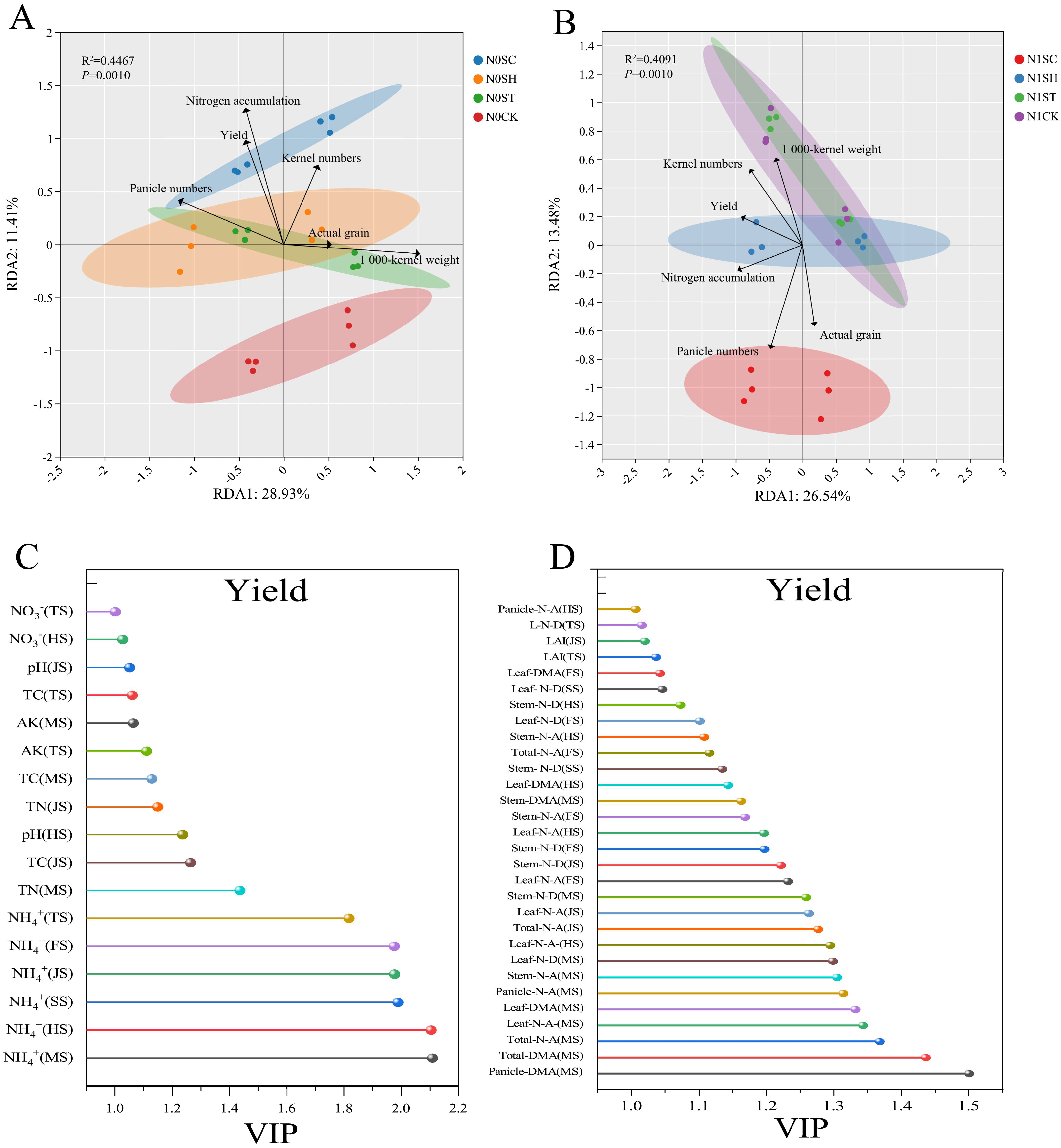
| Properties | pH | Total Carbon | Total Nitrogen | Bulk Density | Ammonium Nitrogen | Nitrate Nitrogen | Available Phosphorus | Available Potassium | Cation Exchange Capacity |
|---|---|---|---|---|---|---|---|---|---|
| unit | - | g/kg | g/kg | g/cm3 | mg/kg | mg/kg | mg/kg | mg/kg | cmol/kg |
| Soil | 6.70 | 12.75 | 1.51 | 1.40 | 4.82 | 8.89 | 2.86 | 128.72 | 14.8 |
| Year | Treatments | Effective Panicle (×104 ha−1) | Spikelet Panicle | Grain Filling Rate (%) | 1000-Grain Weight (g) | Yield (t ha−1) |
|---|---|---|---|---|---|---|
| 2022 | N0SC | 234.67 ± 4.91 c | 129.15 ± 5.15 cde | 97.34 ± 0.58 a | 26.96 ± 0.48 a | 6.13 ± 0.09 c |
| N0SH | 222.33 ± 3.18 c | 123.05 ± 4.66 de | 96.51 ± 0.52 a | 26.84 ± 0.24 a | 5.37 ± 0.34 cd | |
| N0ST | 183.33 ± 7.36 d | 126.76 ± 4.19 de | 96.91 ± 0.20 a | 27.20 ± 0.21 a | 4.58 ± 0.08 d | |
| N0CK | 241.67 ± 1.45 c | 116.00 ± 2.31 e | 96.67 ± 0.56 a | 27.64 ± 0.10 a | 5.81 ± 0.11 c | |
| N1SC | 359.67 ± 6.89 a | 140.57 ± 4.54 bcd | 96.53 ± 0.16 a | 25.14 ± 0.22 b | 9.37 ± 0.18 ab | |
| N1SH | 326.67 ± 7.86 b | 151.74 ± 2.22 abc | 95.44 ± 0.56 ab | 25.07 ± 0.14 b | 8.85 ± 0.13 b | |
| N1ST | 320.33 ± 7.80 b | 166.01 ± 8.44 a | 93.21 ± 2.19 ab | 27.49 ± 0.39 a | 10.32 ± 0.17 a | |
| N1CK | 324.00 ± 5.03 b | 154.26 ± 4.34 ab | 89.64 ± 2.51 b | 27.06 ± 0.41 a | 9.11 ± 0.30 b | |
| 2023 | N0SC | 292.67 ± 1.86 b | 119.62 ± 1.92 a | 97.04 ± 0.09 a | 25.85 ± 0.25 a | 6.26 ± 0.15 c |
| N0SH | 291.67 ± 13.64 b | 114.46 ± 3.19 a | 94.34 ± 1.81 a | 24.36 ± 0.15 b | 5.74 ± 0.02 cd | |
| N0ST | 235.33 ± 11.02 c | 131.05 ± 6.51 a | 96.60 ± 0.55 a | 25.36 ± 0.44 ab | 5.60 ± 0.06 de | |
| N0CK | 227.33 ± 12.20 c | 117.26 ± 3.46 a | 97.71 ± 0.25 a | 25.99 ± 0.24 a | 5.03 ± 0.17 e | |
| N1SC | 337.67 ± 8.37 a | 130.62 ± 5.22 a | 95.62 ± 0.51 a | 25.77 ± 0.23 a | 8.23 ± 0.18 a | |
| N1SH | 317.33 ± 5.93 ab | 128.18 ± 1.86 a | 94.21 ± 1.80 a | 24.35 ± 0.13 b | 6.98 ± 0.03 b | |
| N1ST | 308.33 ± 2.33 ab | 125.11 ± 5.21 a | 94.70 ± 1.13 a | 25.14 ± 0.19 ab | 6.87 ± 0.17 b | |
| N1CK | 324.33 ± 6.89 ab | 126.74 ± 1.61 a | 97.03 ± 0.25 a | 25.88 ± 0.31 a | 7.75 ± 0.03 a | |
| ANOVA | N | p < 0.01 | p < 0.01 | p < 0.01 | p < 0.01 | p < 0.01 |
| Straw | p < 0.01 | p < 0.05 | 0.07 | p < 0.01 | p < 0.01 | |
| Year | p < 0.01 | p < 0.01 | p < 0.01 | p < 0.01 | p < 0.05 | |
| N×S | p < 0.01 | 0.08 | 0.12 | 0.09 | p < 0.01 | |
| N×Y | p < 0.01 | p < 0.01 | 0.07 | p < 0.01 | 0.07 | |
| Y×S | p < 0.05 | 0.09 | p < 0.05 | p < 0.01 | p < 0.05 | |
| N×Y×S | p < 0.01 | p < 0.01 | 0.08 | p < 0.05 | 0.10 |
Disclaimer/Publisher’s Note: The statements, opinions and data contained in all publications are solely those of the individual author(s) and contributor(s) and not of MDPI and/or the editor(s). MDPI and/or the editor(s) disclaim responsibility for any injury to people or property resulting from any ideas, methods, instructions or products referred to in the content. |
© 2025 by the authors. Licensee MDPI, Basel, Switzerland. This article is an open access article distributed under the terms and conditions of the Creative Commons Attribution (CC BY) license (https://creativecommons.org/licenses/by/4.0/).
Share and Cite
Sun, Y.; Ren, B.; Liu, C.; Yan, B.; Lin, L.; Zhao, Y.; Xu, H.; Zhang, W.; Cheng, X.; Han, X. Evaluating the Adaptability and Sustainability of Different Straw Incorporation Strategies in Northeastern China: Impacts on Rice Yield Formation, Nitrogen Use Efficiency, and Temporal Soil Nutrient Dynamics. Agronomy 2025, 15, 729. https://doi.org/10.3390/agronomy15030729
Sun Y, Ren B, Liu C, Yan B, Lin L, Zhao Y, Xu H, Zhang W, Cheng X, Han X. Evaluating the Adaptability and Sustainability of Different Straw Incorporation Strategies in Northeastern China: Impacts on Rice Yield Formation, Nitrogen Use Efficiency, and Temporal Soil Nutrient Dynamics. Agronomy. 2025; 15(3):729. https://doi.org/10.3390/agronomy15030729
Chicago/Turabian StyleSun, Yuanyuan, Bida Ren, Chang Liu, Bingchun Yan, Li Lin, Yanze Zhao, Hai Xu, Wenzhong Zhang, Xiaoyi Cheng, and Xiaori Han. 2025. "Evaluating the Adaptability and Sustainability of Different Straw Incorporation Strategies in Northeastern China: Impacts on Rice Yield Formation, Nitrogen Use Efficiency, and Temporal Soil Nutrient Dynamics" Agronomy 15, no. 3: 729. https://doi.org/10.3390/agronomy15030729
APA StyleSun, Y., Ren, B., Liu, C., Yan, B., Lin, L., Zhao, Y., Xu, H., Zhang, W., Cheng, X., & Han, X. (2025). Evaluating the Adaptability and Sustainability of Different Straw Incorporation Strategies in Northeastern China: Impacts on Rice Yield Formation, Nitrogen Use Efficiency, and Temporal Soil Nutrient Dynamics. Agronomy, 15(3), 729. https://doi.org/10.3390/agronomy15030729






